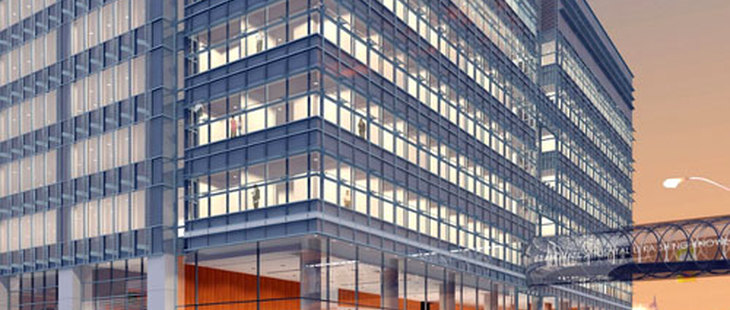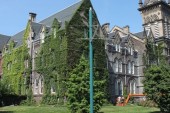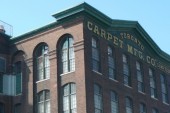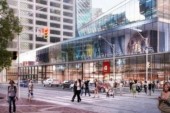

The 5 Avenue Road bus never comes when you need it to. In its place, you’ll see a parade of cabs streak by — all of them, of course, vacant. In cases like these, I usually wait. But this morning I caved.
I split the cab ride down Avenue Road with the only other person at the bus stop. From our backseat introductions, I learned she was a clinical researcher at Princess Margaret Hospital. Her mother was a patient there, her job involved testing cancer drugs, and she did her undergrad neuroscience at Queen’s in the ‘90s.
My stop came before hers. As we pulled up to the curb, I scooped out the change in my wallet and hopped out of the car. A few seconds later I realized I never caught her name.
She was another one of the 13,000 researchers who spend their nine-to-five lives in the Discovery District. As a neighbourhood, it’s the kind of place you tend to forget when you think about Toronto. There aren’t many restaurants, or shops, or places to go out in the evening. After dark, the only thing left along the empty streets are the lit-up spectres of glass and steel — the buildings make up the city’s biomedical empire.
It’s strange to think that some of the most impressive research in the country takes place a stone’s throw from the Eaton’s Centre. The Li Ka Shing Knowledge Institute, at Shuter and Victoria Street, is the latest addition to the Discovery District’s architectural portfolio. From the sidewalk, you can see through the building’s glass walls into open spaces and wooden stairways. This place is like a scientific Scandinavia. It’s beautiful on purpose.
A. J. Diamond, of Diamond and Schmitt Architects, explains that there’s a point to making research centres look and feel this good. “The first and most important thing is to create a great quality of place, so that people want to be there. They’re not trying to get away from it to go home.”
Diamond and Schmitt finalized the design for the Li Ka Shing in 2006, and construction was completed last fall. Buildings like this one are a running theme in research. The idea is to get scientists from different fields talking to one another, in order to solve larger problems that go beyond their individual expertise.
We don’t often realize how much physical space can change the way we generate ideas. The Ikea feel isn’t just an aesthetic thing. It’s about creating a place where researchers can strike up informal conversations and eventually collaborate. According to Diamond, these informal points of contact are the key to multidisciplinary research. And there are a few rules for making those connections happen.
“At a very simple level, you never put researchers’ offices on the same side of the corridor as the laboratory,” says Diamond. “You put them on the opposite side, so they’re bound to go between the two. So, for example, students or post-docs or other faculty members will in fact have a chance of getting a glimpse of them and saying, ‘Oh, by the way, I had an idea.’”
These principles have seen a good deal of practice in the northern end of the Discovery District, at the Terrence Donnelly Centre for Cellular and Biomolecular Research. Completed in 2005, the Donnelly is a floating Rubik’s cube at the northwest corner of University and College. The researchers who work there hail from fields like engineering, medicine, computer science, and chemistry to tackle the cause and cure of disease.
Dr. Molly Shoichet is a principal investigator at the Donnelly, where her lab takes an engineering approach to repairing or regenerating the body when it can’t do so on its own. Her projects include repairing tissues in the brain after a stroke, and transplanting stem cells into the eye to overcome blindness.
“The office that I worked in previously, before the Donnelly Centre was built, was probably twice the size of my current office. So just by having small offices, people get out of their office,” says Shoichet.
Shoichet works on the fifth floor of the Donnelly, where she met Karen Maxwell. Their initial conversations eventually led to important collaborations between the two labs. “These are collaborations that I never would have had, because I never would have crossed paths with these people.”
“The labs themselves are all open concept,” Shoichet continues. “On the fifth floor, there are three labs, and we all share one giant space. The giant space is divided up into the different labs, but it’s all open. There’s no door you even have to go through to get into the next lab. All the students have their offices right next to the lab, so there’s a lot of cross-talk amongst the students, amongst the researchers in the lab, amongst the principal investigators and professors. So the space was really designed with collaboration in mind.”
Of course, collaborations don’t just happen within the same building. As Shoichet points out, Toronto is big, but the research community is quite close. The Discovery District encompasses only 1.6 square miles. The neighbourhood is bounded by Bloor in the north, Queen in the south, Bay in the east, and Spadina in the west — making it the densest geographical centre for research in the world.
As an official neighbourhood, The Discovery District itself is only a decade old. It was the brainchild of Matt Buist, who manages business development in medical and biotechnology for the City of Toronto. The district was a way to formally establish the research community that already existed in the city’s downtown core, and to also highlight business opportunities in the biomedical sector.
The neighbourhood is now a big money-maker for Toronto — an intellectual Bay Street, if you will, that scraps the tie for a lab coat. It isn’t just a neighbourhood, it’s also a brand.
“I started looking around for a name for it,” says Buist. “There were all sorts of suggestions — “Medical Mile,” “Research Alley,” and things like that. […] And then I was visiting my mother in Northeast Scotland, in the city of Dundee. And Dundee is the city that built that the royal ship “Discovery,” which was used by one of the famous explorers to explore Antarctica. I was exploring the ship, and thought, ‘Discovery, what a wonderful name: scientific discovery.’ And hence the name Discovery District came about.”
You could argue that the Discovery District isn’t a neighbourhood in the usual sense, because it was originally based on a brand rather than more “organic” processes. Yet in the past ten years, the buildings that have come to populate the area have created a personality of their own. We’re seeing a new scientific culture emerge in the centre of our city. It comes from researchers who are willing to collaborate, and designers who understand how physical space can contribute to research.
“Disciplines no longer have their hard and fast edges and boundaries,” says Diamond. ”It’s of necessity that we have to have buildings that in fact acknowledge the breakdown of these components, and what I call convergence. It used to be that analysis was enough to really understand a subject. Now you need synthesis. You need to put stuff together.”














